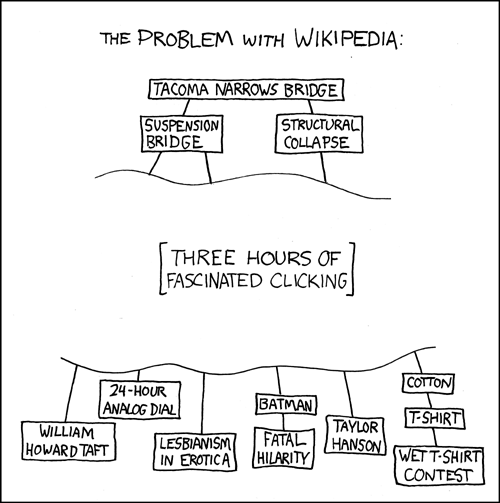I’ve been meaning to comment on Mathew Ingram’s defence of newspapers and serendipity. Clay Shirky has been talking about the bundling that occurs in newspapers as a mere accident of print, something that was only necessary given the constraints of paper, but doesn’t make sense otherwise. Mathew disagrees:
Is there a purpose in aggregating the horoscope and the weather and the news about the coup in Tegucigalpa? I think there is, and I think newspapers do a pretty good job of it.
It’s not just because they have to — although that’s part of it. Maybe I’ve just been trained as a newspaper reader for my whole life, but I like the serendipity of tripping over fascinating articles about things I would never have known even existed were it not for a newspaper. To take the Saturday Globe and Mail as an example, I read about an up-and-coming Muslim hockey player, a profile of Paul Shaffer, a review of the punk band Gossip, an article about contentious city council politics in Aurora and a great feature on retirees and their vanishing pensions.
Just two days before Mathew’s post, my friend Emilie and I were having the same conversation. She reads the newspaper daily and made the same defence. I used to read the paper regularly when I was commuting to school in Grade 9, but more recently, I’ve come to get my “news” through Gwibber and Google Reader. It’s not that Mathew or Emilie don’t use the web, but they both have found something valuable in newspapers that the web hasn’t been able to offer — information serendipity (by that, I mean serendipity with respect to encountering ideas). Mathew continues,
Could links to those stories show up in my RSS reader? Possibly – but I doubt it. The mix is just too eclectic. And I would never have sought out the article about the Muslim hockey player, because I don’t particularly care about hockey and therefore I would likely never have come across it. Would the retirement piece ever make it to Techmeme or some similar aggregator? I doubt it. But it was still worth reading. And so were the half-dozen or so articles I can’t recall right now, which I tripped across as I read the paper. I would never have deliberately sought them out either.
I think Mathew’s missing one of the most serendipitous aspects of the web — the social aspect. I wouldn’t likely stumble upon those sorts of articles through my RSS subscriptions (though I’m subscribed to some pretty eclectic stuff), but through Google Reader shared items (e.g. Turadg Aleahmad shares some really interesting things, like this Wikipedia article on Mamihlapinatapai). I stumbled across Valaam chant through a friend’s Facebook posted items the other day, a genre of music that’s entirely new to me and will likely influence my own music. I find interesting links through Twitter/Identi.ca every week that are outside my regular areas of interest (e.g. this video riding blog from Sunday). I may follow someone who shares some interests in common with me, but that doesn’t mean their other interests are my usual fare. Information serendipity here is social.
Then, beyond the social, Mike Masnick was writing about serendipity of search a few weeks before Mathew’s post:
There’s a separate side of having search so ingrained in our lives that isn’t often explored: the serendipity of search… I do a countless number of searches during the day — it’s ingrained to quickly and automatically jump to the search box all through the day — and usually two or three times per day, I end up going down a fascinating, if unexpected path to learning something new and interesting. Usually, it’s related to what I was originally searching for, but leads me on a trail of additional information, well beyond what I expected to learn. Other times, it may be a total tangent, but still one that ends up being useful and relevant in odd and unexpected ways.
A couple days after Mike’s post, I was watching Margaret Visser’s The Geometry of Love with the RCIA group at the Newman Centre. She makes a passing comment in the video about the serendipity of browsing through the stacks at Robarts Library — yet another type of information serendipity.
Beyond information serendipity, there’s a likelihood of social serendipity (in encountering people rather than ideas) that exists in a communications medium like the web that you wouldn’t find in a newspaper. On any medium, it’s not so much a question of whether there’s an element of serendipity as it’s a question of what that serendipity is like.
Information serendipity on the web is different than in newspapers. There’s information serendipity in bundling, in proximity, in linking, in social connections, and then there are other types of serendipity altogether, like social serendipity. I think it’d be really interesting to dig deeper and explore the differences…




